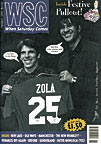 Cris Freddi pays tribute to former England international centre forward Tommy Lawton, who died in November
Cris Freddi pays tribute to former England international centre forward Tommy Lawton, who died in November
Five foot eleven has got to be a misprint. Reading about the famous ability in the air, you expect something like Niall Quinn but heavier (he looks that big in photos and film clips) and instead you have to adjust to the idea of a white Les Ferdinand, which isn’t exactly the stuff of folklore.
But Tommy Lawton was a more classic centre-forward than that, the kind that leads a line, laying the ball off under a defender’s challenge before coming at you again to take the return pass or high cross and score with head and either foot. Which makes him what? Ferdinand crossed with a Mark Hughes the size of Skuhravy? It doesn’t get any prettier.
But let’s stop all this. There are some players you don’t need to compare with what’s around at the moment to prove they could’ve done equally well today. Lawton understood that, especially about himself. Upright, brylcreemed and smiling, he looked – and knew he was – every inch a star. There was never a more confident player.
First capped at 19, he was already cocky enough to take a penalty on his England debut. He scored in each of his first six internationals and was just beginning to challenge the great Piola (who died only a few weeks before him) for the title of world No 1 when the war came and cut seven years out of his career. If it hadn’t, he’d still be England’s leading goalscorer, don’t doubt it – and he wouldn’t have needed Charlton’s 106 caps or Lineker’s 80. His 22 official goals and 25 in wartime internationals were scored at one a game. In 1939 he matched Piola goal for goal in Milan; in Turin nine years later, his killing strike put England two up in a famous match they won 4-0. It was his last international goal, as good as any of them: the keeper didn’t move. Not bad for someone suffering from flat feet and sciatica.
He scored his share in domestic football too,enough to twice make him First Division leading scorer, win Everton the League title in 1939, and take Notts County to promotion eleven years later – but the fact that the England centre forward, in his prime, should be playing for a third division club says something about Lawton’s place in the history of footballers as employees. The move from Chelsea in 1947 (the first £20,000 transfer in Britain) was something he asked for, and while his pay was frozen at £12 a week, unofficially there were ways round the maximum wage, especially when County’s gates shot up from 9,000 to 35,000. If anyone ever expected to find a little extra cash in his boots, you can be sure it was Tommy Lawton. He knew his own worth.
Unfortunately this was never measured in pounds and pence. Towards the end of his life, people seemed to be forever organizing testimonials and benefits for him, and it is unlikely that he was ever really comfortable financially. If today’s salaries are obscene, at least it suggests the leading players do not have to undergo the humiliations of Lawton’s day. In one of his last TV interviews, thin and unwell, working hard to get the words out, he remembered being told by a club official to go back out, knock on the door, then wait till he was told to come in before entering the room. Try telling him agents are monster bad for the game.
They’d have done well out of him, too. Given that he and Stan Mortensen scored four apiece in their first international together, he’d have slotted in alongside Shearer no problem. Then we’d see who had the biggest price tag.
From WSC 119 January 1997. What was happening this month